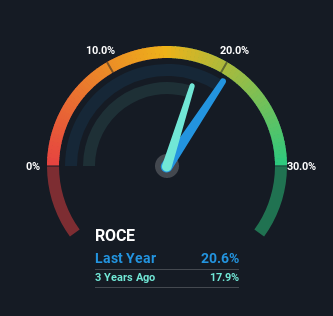- United States
- /
- Electronic Equipment and Components
- /
- NasdaqGS:PLUS
ePlus (NASDAQ:PLUS) Is Reinvesting To Multiply In Value

What trends should we look for it we want to identify stocks that can multiply in value over the long term? In a perfect world, we'd like to see a company investing more capital into its business and ideally the returns earned from that capital are also increasing. This shows us that it's a compounding machine, able to continually reinvest its earnings back into the business and generate higher returns. With that in mind, the ROCE of ePlus (NASDAQ:PLUS) looks attractive right now, so lets see what the trend of returns can tell us.
Understanding Return On Capital Employed (ROCE)
Just to clarify if you're unsure, ROCE is a metric for evaluating how much pre-tax income (in percentage terms) a company earns on the capital invested in its business. Analysts use this formula to calculate it for ePlus:
Return on Capital Employed = Earnings Before Interest and Tax (EBIT) ÷ (Total Assets - Current Liabilities)
0.21 = US$149m ÷ (US$1.3b - US$534m) (Based on the trailing twelve months to June 2022).
Therefore, ePlus has an ROCE of 21%. In absolute terms that's a great return and it's even better than the Electronic industry average of 12%.
Check out our latest analysis for ePlus

In the above chart we have measured ePlus' prior ROCE against its prior performance, but the future is arguably more important. If you'd like, you can check out the forecasts from the analysts covering ePlus here for free.
What The Trend Of ROCE Can Tell Us
ePlus deserves to be commended in regards to it's returns. The company has consistently earned 21% for the last five years, and the capital employed within the business has risen 93% in that time. With returns that high, it's great that the business can continually reinvest its money at such appealing rates of return. If ePlus can keep this up, we'd be very optimistic about its future.
Another thing to note, ePlus has a high ratio of current liabilities to total assets of 43%. This effectively means that suppliers (or short-term creditors) are funding a large portion of the business, so just be aware that this can introduce some elements of risk. While it's not necessarily a bad thing, it can be beneficial if this ratio is lower.
The Key Takeaway
In short, we'd argue ePlus has the makings of a multi-bagger since its been able to compound its capital at very profitable rates of return. And given the stock has only risen 18% over the last five years, we'd suspect the market is beginning to recognize these trends. So because of the trends we're seeing, we'd recommend looking further into this stock to see if it has the makings of a multi-bagger.
If you'd like to know more about ePlus, we've spotted 2 warning signs, and 1 of them is potentially serious.
High returns are a key ingredient to strong performance, so check out our free list ofstocks earning high returns on equity with solid balance sheets.
New: Manage All Your Stock Portfolios in One Place
We've created the ultimate portfolio companion for stock investors, and it's free.
• Connect an unlimited number of Portfolios and see your total in one currency
• Be alerted to new Warning Signs or Risks via email or mobile
• Track the Fair Value of your stocks
Have feedback on this article? Concerned about the content? Get in touch with us directly. Alternatively, email editorial-team (at) simplywallst.com.
This article by Simply Wall St is general in nature. We provide commentary based on historical data and analyst forecasts only using an unbiased methodology and our articles are not intended to be financial advice. It does not constitute a recommendation to buy or sell any stock, and does not take account of your objectives, or your financial situation. We aim to bring you long-term focused analysis driven by fundamental data. Note that our analysis may not factor in the latest price-sensitive company announcements or qualitative material. Simply Wall St has no position in any stocks mentioned.
About NasdaqGS:PLUS
ePlus
Provides information technology (IT) solutions that enable organizations to optimize their IT environment and supply chain processes in the United States and internationally.
Flawless balance sheet and slightly overvalued.


